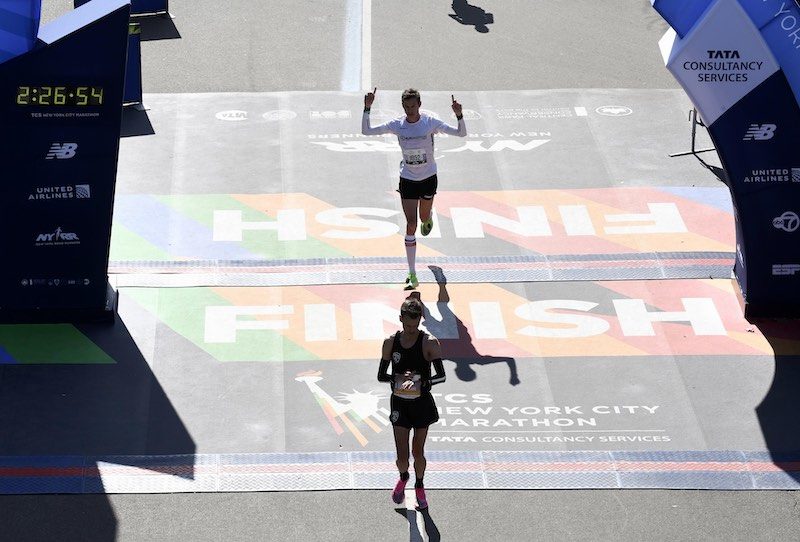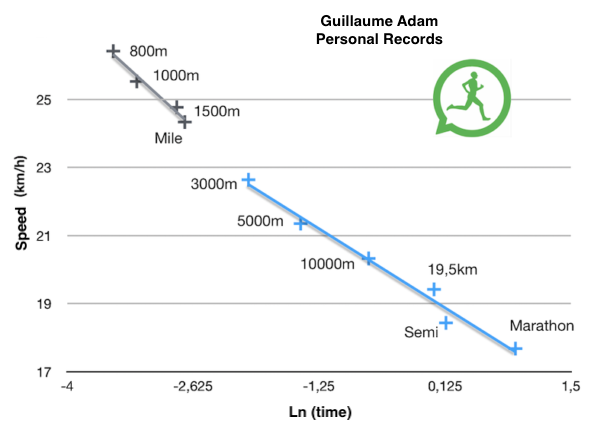
Only four independent parameters model running performance. The MIT-developed model accurately predicts performance and establishes training paces. These parameters correspond to a speed close to Velocity at VO2max (vVo2max), a time close to vVO2max support time, short distance endurance and long distance endurance.
I present the model to which I contributed in a research project at MIT (Boston), in a CNRS and MIT laboratory. It is the subject of a scientific publication “A minimal power model for human running performance” which I co-authored with Thorsten Emig and Matthew Mulligan.
This article explains the model’s main features and how training speeds are calculated in RunMotion Coach.
Contents
2 important definitions: Velocity at VO2max and Endurance
The Velocity at VO2max (vVO2max or MAS) is the velocity, at which the runner consumes the maximum amount of oxygen (the VO2max). In concrete terms, above the vVO2max, the runner exhausts himself very quickly.
Studies indicate that a runner can maintain vVO2max for 4 to 7 minutes, which is the vVO2max support time.
Endurance is a runner’s ability to run for a long period of time with an specific intensity
There are 2 types of endurance: short and long distances
I present below my own performance curve with all my personal records.

We can see in the graph that it is possible to group these points into 2 groups.
We’ve identified two endurance types: short distance endurance (in black) for roughly 2 to 6 minutes, and long distance endurance (in blue) for approximately 6 minutes to several hours (typically 4 to 5 hours).
The 6-minute duration isn’t fixed but corresponds to the intersection of the two straight lines. This point (with the coordinates Vm and tc in our model) is close to the vVO2max and the support time of the vVO2max: 22.9km/h for me.
The flatter the slope, the longer the runner is able to hold a given intensity, the more enduring he is.
Although it may seem surprising, endurance does not depend in the level of the runner. 2 runners in 2h30 and 4h at the marathon can have the same endurance while the runner’s vVO2max in 2h30 is higher than in 4h.
Personally, my short distance endurance is very good, and my long distance endurance is average.
To establish the 4 parameters, you need a minimum of 2 races under 6 minutes and 2 races over 6 minutes, each at varying distances. Typically: 800 meters, 1500 meters, 3000 meters and 10 kilometers.
What are the limits of our model?
If the runner does not have references over this large range of distances, we can set certain parameters and focus only in short (less than 6 minutes) or long distances (more than 6 minutes).
In RunMotion Coach, we focus on races lasting between 6 minutes and 5 hours, which aligns with the majority of our users’ road and trail races. Additionally, athletes should compete in these races with maximum effort and maintain consistent fitness levels.
My graph illustrates my best races – the 1500 meters, 3000 meters, and the “Duc’s Race” (a 19.5km road race), all of which exceed the two reference lines.
On the contrary, the 1000m, the 5000m and the half marathon are well below. These 3 distances are the ones that I optimized the least in competition or realized in seasons where I wasn’t in great shape. Thus on half-marathon, the model predicts 1h06’26 to me, 2 minutes better than my current record.
In the marathon, I adjusted for the 250m New York Marathon altitude difference using a correction coefficient. A German coach, after comparing numerous races with and without elevation gain, provided coefficients for positive and negative elevation gain to determine an equivalent flat speed.
RunMotion Coach app considers elevation differences and adjusts coefficients, especially on trails due to their technical nature.
In addition, when the runner has races that are not at the same level of performance, we apply a filter to remove the “worst” races: those that are well below the line. This is typically the case when the weather conditions are not ideal: too hot or bad conditions.
The model’s sprint limit is no longer valid, and in efforts exceeding 4 to 5 hours, factors like muscular and central nervous system fatigue impact performance.
How to calculate your training paces?
You may have already seen tables of % vVO2max for intervals. For example running a 1000m at 90% of the vVO2. The problem with these tables is that it only works if you have “classic” endurance.
With our model, the training paces are calculated directly for the theme of the session. For example, a 6×1000 meters session at 10km pace will directly take your theoretical time over 10km. Moreover, we apply a progression to the paces when you want to beat your record.
My practical recommendations to get the right training paces
If training paces seem too low or high, reach out via the contact at the page’s bottom to review calculated vVO2max and endurance. Adjustments can be made, particularly in trails where altitude coefficients may not account for technicality or weather conditions effectively.
I recommend that you enter at least 2 of your best performances over distances that are twice as long as each other. For example 5km & 10km, 10km & half marathon, or half marathon & marathon.
Moreover, if you know your vVO2max (also called MAS), you can add in your past races a 1.6km race with a time of 6 minutes for example if your vVO2max is 16km/h. Simply divide your vVO2max in kilometres per hour by 10 and enter the corresponding distance and a time of 6 minutes.
The long distance endurance index
In conclusion, it’s worth noting that Peronnet and Thibault recognized the linear relationship between speed and the Naperian logarithm of time for long distances back in the 1980s. The endurance index is calculated in this way :
Endurance index = (% of vVO2max held during the race – 100) / Ln (race time / 6)
There are sometimes variations, with the 6 replaced by a 7, depending on whether you take the vVO2max support time in 6 or 7 minutes.
Go further with our model
If you want to know more about our model and find all the mathematical formulas 😉, I invite you to read our scientific publication “A minimal power model for human running performance”. The model has been validated in thousands of runners.
You can calculate your endurance using our performance prediction calculator, revealing your vVO2MAX and endurance through two race results.
From this model, it might even be possible to detect abnormal performance (doping) or detect high potentials. Also, we can see if to optimize a performance, it is preferable for a given runner to develop his vVO2max or endurance as a priority.
In addition to applying to the personal scale, the model applies to world records, as I wrote in this article. World records in half marathons and marathons appear to benefit from recent advancements in footwear technology.